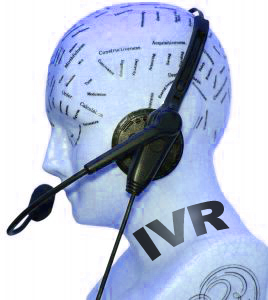Monday, February 6, 2012
By Jeff Spisak
One of CallFire’s signature features is the Interactive Voice Response application, or IVR. For a long time the IVR was a developer tool to make interesting phone applications. However, the practical applications of the tool make IVR technology a staple for any business. This brief article will tell you what an IVR is, how it works, and how you can make the CallFire IVR work for you.
 The voice mail module is another popular IVR subtype, which is integrated with CallFire's call tracking solution. Purchase a toll-free or local number from CallFire, and then use the IVR to create a voice mail mailbox. You may set it up so that calls that forward to your business and the calls that are not answered will be transferred directly to the voice mail. Calls can also be transferred directly to your voicemail, where the caller can leave a message that you retrieve later. This can also be used with the business tree—if no one reaches a particular extension, they can leave a message. Together, these aspects of the IVR make it a powerful tool for businesses of all sizes. In addition to its abilities to process inbound calls, the IVR is essential for surveying large audiences. The largest application of this survey functionality is using the IVR to conduct political polling. Its all very simple: upload a list of potential voters and send out a survey to gauge the level of support for your candidate. Perhaps you are in favor of building new bridges in your community? Then send out a survey that asks voters if they are in favor, and if so, to what degree? Your results may even show up on the cable news shows. Beyond the political use case, IVR polling can be utilized by all sorts of organizations to gauge sentiment among members. These are just a few of the myriad possibilities offered by the CallFire IVR. Come join our weekly webinar, every Wednesday at 11:00 AM Pacific time. We would be so happy to have you that we may even credit your account with a few bucks just to get you started.
The voice mail module is another popular IVR subtype, which is integrated with CallFire's call tracking solution. Purchase a toll-free or local number from CallFire, and then use the IVR to create a voice mail mailbox. You may set it up so that calls that forward to your business and the calls that are not answered will be transferred directly to the voice mail. Calls can also be transferred directly to your voicemail, where the caller can leave a message that you retrieve later. This can also be used with the business tree—if no one reaches a particular extension, they can leave a message. Together, these aspects of the IVR make it a powerful tool for businesses of all sizes. In addition to its abilities to process inbound calls, the IVR is essential for surveying large audiences. The largest application of this survey functionality is using the IVR to conduct political polling. Its all very simple: upload a list of potential voters and send out a survey to gauge the level of support for your candidate. Perhaps you are in favor of building new bridges in your community? Then send out a survey that asks voters if they are in favor, and if so, to what degree? Your results may even show up on the cable news shows. Beyond the political use case, IVR polling can be utilized by all sorts of organizations to gauge sentiment among members. These are just a few of the myriad possibilities offered by the CallFire IVR. Come join our weekly webinar, every Wednesday at 11:00 AM Pacific time. We would be so happy to have you that we may even credit your account with a few bucks just to get you started.